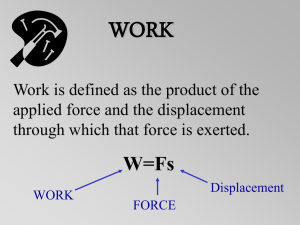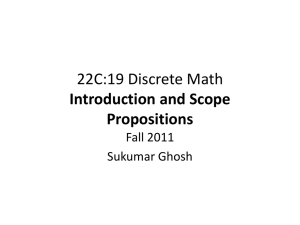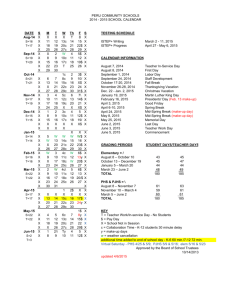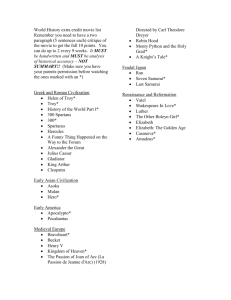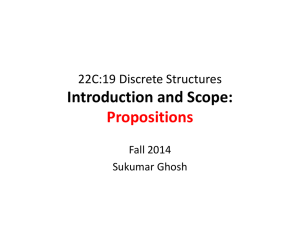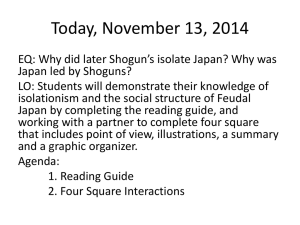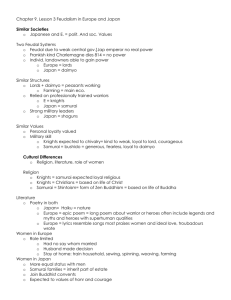Nakamura
advertisement
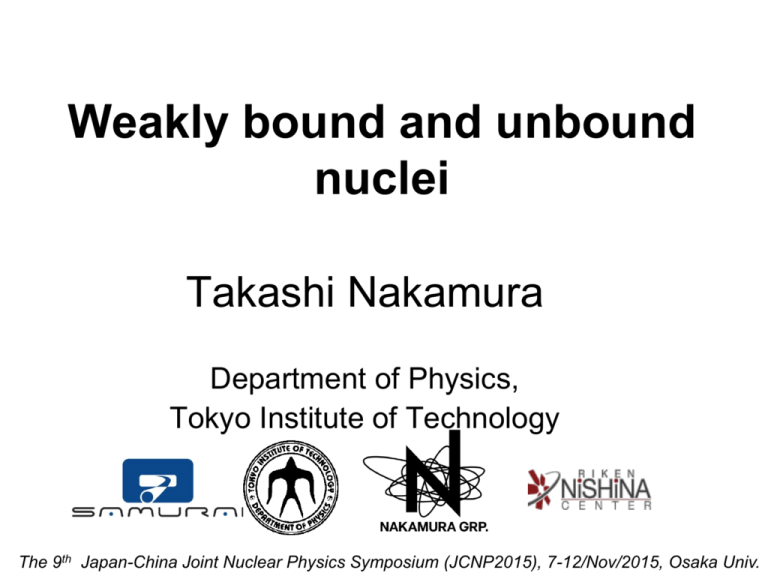
Weakly bound and unbound nuclei Takashi Nakamura Department of Physics, Tokyo Institute of Technology The 9th Japan-China Joint Nuclear Physics Symposium (JCNP2015), 7-12/Nov/2015, Osaka Univ. Contents Introduction: Drip Lines and Barely bound/unbound nuclei Probes: Coulomb and Nuclear Breakup at intermediate energies SAMURAI Facility at RIBF at RIKEN Coulomb/Nuclear Breakup of Borromean 2n-Halo 22C Spectroscopy of 25O,26O -- @ SAMURAI at RIBF Summary and Outlook Characteristic Nuclear structure near neutron-drip line? b-Stable Neutron Drip-line Beyond 1n separation energy Sn=8MeV p n More n-rich Sn<1MeV -1MeV<Sn<0MeV continuum p n continuum p n Neutron Drip Line Fermi levels between n and p—Very Different Valence neutron – Loosely-Bound/Unbound Neutron Halo/Skin (Neutron-matter surface) Continuum Strong cluster-like correlation dineutron? A.B.Migdal Strongly correlated “dineutron” on the surface of a nucleus Dineutron? Sov.J.Nucl.Phys.238(1973). n n Unbound a= -18 fm n n S=1 Dineutron: @ Low-dense neutron skin/halo? /surface of neutron star? M.Matsuo PRC73,044309(2006). A.Gezerlis, J.Carlson, PRC81,025803(2010) Electric-Dipole (E1) Response of 11Li 11Li n-star 12 n n core Dineutron Correlation Strongly Polarized Strong E1 Excitation B( E1) 1.42 0.18 e 2 fm2 ( Erel 3MeV ) 14 12 4818 deg . T.N. et al. PRL96,252502(2006). Indirect Hint of Dineutron Correlation Evolution Towards the Stability Limit Where is the neutron drip line? What are characteristic features of drip-line nuclei? How does nuclear structure evolve towards the drip line? Shell? Ca K Deformation? Ar Cl Halo? S Drip Line? Si P N=28 Continuum? Al He H Mg Na Ne F N=20 N=16 O N 37Mg C B Be Li 21C N=8 18B 19B 25O 26O28 22C 31Ne O 1n halo known 2n halo known 4n halo/skin Probes– Nuclear and Coulomb breakup of drip-line nuclei at intermediate energies Probe-1: Nuclear Breakup – Case of 1n Halo e.g. 1n knockout reaction of 31Ne 31Ne 240MeV/u (TN et al. , PRL112,142501 (2014).) 30 30Ne P ( Ne) 31Ne* 30 Ne n C Target (g) p f P// ( 30 Ne) g ray in coincidence 30Ne(2+) / 30Ne(0+) Contribution s-1n and P// distribution of valence n, configuration Theory: Eikonal Approximation New 1n Halo Systems 31Ne and 37Mg: 31Ne S n 0.1500..16 10 MeV 30Ne core p-wave halo neutron Deformation b~0.5 (~ 3:2) Strongly deformed although it is N=21 (close to 20) 37Mg: N.Kobayashi, TN et al., PRL 112, 242501, 2014 Probe-1 Nuclear Breakup – Case of 2n Halo e.g. 22C 22C* 20C 22C 20 P(n), P(n), P( C) 12C ds/dErel Inelastic scattering n n 2+ (?) Erel ( 22 C ) ( E x S 2 n ) 21C* 20C 22C n C P//(20C) s d ds/dErel Knockout reaction 12 12C 20 P(n), P( C) Erel ( 21 C ) N.Kobayashi,TN,PRC2012 Probe-2: Coulomb Breakup Photon absorption of a fast projectile 22C 22C* g(virtual photon) b>0.3 High-Z Target (Pb) Equivalent Photon Method dsCB 16p3 dB(E1) = N (E ) dEx 9hc E1 x dEx Cross section = (Photon Number)x(Transition Probability) C.A. Bertulani, G. Baur, Phys. Rep. 163,299(1988). Halo Soft E1 Excitation (E1 Concentration at Ex<1MeV) 20 P(n), P(n), P( C) Invariant Mass E x , Erel 20C n n Di-neutron Correlation Single particle state (Halo) SAMURAI Facility at RIBF at RIKEN RIKEN RI Beam Factory (RIBF) Completed in 2007 New-Generation RI-beam facility SCRIT 2013 SLOWRI 2014 ZDS 2008 SAMURAI 2012 SRC BigRIPS 2007 Rare RI RING 2014 SHARAQ 2009 SRC: World Largest Cyclotron (K=2500 MeV) Heavy Ion Beams up to 238U at 345MeV/u (Light Ions up to 440MeV/u) eg. Increasing Year by Year! 48Ca beam (345 MeV/nucleon) ~200pnA (250pnA max.) 48 Ca:~500pnA 2014 238U beam (345 MeV/nucleon) ~12pnA (15pnA max.) 238U: ~ 30 pnA 2015 SAMURAI Superconducting Analyzer for MUlti-particle from RAdio Isotope Beam Kinematically Complete measurements by detecting multiple particles in coincidence RI beam from BigRIPS Superconducting Magnet (3T, 2m dia. Pole 80cm gap) Large momentum acceptance Brmax / Brmin ~ 2 – 3 Good Momentum Resolution Dp/p~ 1/1500 Large Bending Angle (~60deg) +4 Tracking Detectors T.Kobayashi NIMB317, 294 (2013) Target rotatable Proton Large angular acceptance for n Neutron(s) Heavy Ion +-8.8 deg (H) x +-4.4 deg(V) (~50% coverage < Erel ~ 5MeV) Moderate Erel Resolution DE = 200 keV (s) at Erel=1MeV Stage: Rotatable (-5 -- 95 degrees) Variety of Physics Opportunities SAMURAI Superconducting Analyzer for MUlti-particle from RAdio Isotope Beam March 2012 Breakup Experiments at SAMURAI -- Results from Day-One campaign experiments at SAMURAI Coulomb Breakup of 19B and 22C, Nakamura et al. Study of 18B,21C, and excited states of 19B,22C, Orr et al. Structure of Unbound Oxygen Isotopes 25O,26O, Kondo et al. F O N C B Be Li He H 21C N=8 18B 19B 25O 26O28O 22C 22C (Z=6,N=16) Prominent 2n-Halo? K.Tanaka et al., PRL 104, 062701(2010). S2n= 0.14(46) MeV L.Gaudefroy et al. PRL109,202503(2012). sR(mb) Reaction cross section measurements (<rm2>)1/2=5.4(9) fm c.f. ~3.5 fm11Li 22C Z=8 19C 20C N=16 Magicity? 20 16 A 1d3/2 2S1/2 1d5/2 A.Ozawa et al., PRL 84, 5493 (2000). Heaviest s-wave dominant 2n Halo within reach? c.f. 3s1/2 Halo: Far away for the current and near-future RIB facilities N~60-70 SAMURAI Experiment May/2012 First Full Exclusive Coulomb/Nuclear Breakup Measurement of 22C and 22N DE 23N ~10cps RIBF (~10cph RIPS) 20C 22C Pb3.26g/cm2 C191.79g/cm2 C 19B 17B 19B n 22C+CAZ+X n 2.8 3 3.2 3.4 3.6 3.8 7 4 A/Z 240MeV/nucleon 22C 6 Z 22C 19C20C 5 20C 4 17B 19B 14Be 3 2.4 2.6 2.8 3 3.2 3.4 3.6 3.8 4 A/Z Heavy Ion + 1 neutron : 22C(22N)+C21C*20C+n 22F 23F 24F 25F 26F 27F 28F 29F 30F 21O 22O 23O 24 O 22N21C*20C+n 20N 21N 22N 23N S.Leblond Preliminary 19C 20C 21C 22C 18B 19B Spokesperson: N.A.Orr, J.Gibelin 31F 22N21C*20C+n S.Mosby et al.(MSU) NPA909,69(2013). N=16 s 20 16 22C21C*20C+n 1d3/2 Preliminary 2S1/2 1d5/2 Erel(MeV) 8 2 2 1s1/2 22C s d 1p1/2 1p3/2 0 0 1 2 3 Edecay(MeV) 4 5 Spectra 1 2 Edecay(MeV) from S.Leblond/N.A. Orr 3 Coulomb Breakup of 22C (20C+n+n Spectrum) Spokesperson: T.Nakamura 22C+Pb22C* 20C+n+N counts R.Minakata (Tokyo Tech) 0 1 2 3 4 5 Erel(MeV) 6 7 8 9 10 Study of unbound nuclei 25O and 26O at SAMURAI Spokesperson Yosuke Kondo Experimental study of unbound oxygen isotopes towards the possible double magic nucleus 28O T. Otsuka et al., PRL105, 032501 (2010). 24Ne 25Ne 26Ne 27Ne 28Ne 29Ne 30Ne 31Ne 32Ne 23F 24F 25F 26F 27F 28F 29F 30F 22O 23O 24 O 25O 26O 27O 28O 21N 22N 23N 20C 21C 22C 19B N=16? Drip line Drip line 31F Z=8 N=20 Oxygen Anomaly 3N force: significant at N>16 G. Hagen et al., PRL108, 242501(2012). H. Hergert et al., PRL110, 242501(2013). S.K.Bogner et al., PRL113, 142501(2014). Continuum Effect: A.Volya, V.Zelevinski, PRL94,052501(2005). nn correlations: L.V. Grigorenko et al., PRL111,042501(2013). K. Hagino, H. Sagawa PRC89,014331(2014). 2n radioactivity of E. Lunderberg et al. PRL108, 142503 (2012) ~770keV 26O? 25O+n ⊗ (nd3/2)2 26O: 24O(0+) 24O+2n ? x 26O L.V. Grigorenko et al. PRC 84, 021303 (2011) C. Caesar et al.PRC88, 034313 (2013) Er < 200keV Z. Kohley et al,PRL110,152501 (2013) T1/2=4.5+1.1-1.5ps (3ps systematic error) 2n radioactivity? Usual 1n decay G~MeV or keV Er < 120keV (95% CL) t < 5.7ns Large uncertainty of experimental Excite study state at 4.2MeV? • Only upper limit is given for the ground state energy • Large systematic error in the lifetime measurement • Excited State of 26O? Experimental Setup at SAMURAI at RIBF C target Ionization (1.8g/cm2) Chamber 2Plastics 2 MWDCs MWDC Superconducting Dipole Magnet (B=3.0T) NEBULA n n 27F ~210MeV/u (from BigRIPS) DALI2 MWDC Hodoscope 24O Decay energy spectrum of 25O Edecay Edecay=750keV 25O gs 26F+C 25O*24O+n 24O+n Kondo et al. Edecay=749(10) keV G= 88(6) keV C.R.Hoffman et al.,(MSU) PRL100, 152502 (2008) Previous Works (GSI) C.Caesar, PRC 2013 (MSU) Hoffman, PRL 2008 Decay energy spectrum of 26O (24O+2n, 24O+n) 26O gs 26O gs 24O+n+X Counts /20keV Counts /50keV 27F+C26O24O+2n 26O 1st New! 27F+C26O,25O 26O 1st+ 25O gs Edecay(24O+n) Edecay(24O+n+n) =Edecay(24O+n)+Edecay(25O+n) Edecay(24O+n+n) Finite Value! Edecay ( 26 O gs ) 18 3( stat ) 4( syst ) keV 11 Edecay ( 26 O1st ) 1.2800..08 MeV Most likely 2+ No peak at ~4.2MeV n 24O n Barely unbound nucleus Present Results on 25O and 26O 26O 1.27(11) MeV (2+) 749(10) keV 25O+n 24O+n+n 18(5) keV 25O+n 26O Centrifugal Barrier Extremely weakly UNBOUND state! E 0+ • N=16 shell closure is confirmed • USDB fail to describe E(2+) of 26O Effect of pf shell? 3N-forces, pf shell, continuum Submitted to PRL Next step: Study of 27O and 28O in Nov.-Dec Summary and Outlook Coulomb and Nuclear Breakup Useful tool to probe weakly-bound states (HALO) near/beyond the drip-line 31Ne TN, N.Kobayashi, PRL2014, 37Mg N.Kobayashi, TN, PRL2014. SAMURAI Facility at RIBF (since 2012) Powerful equipment for various experiments using RI beams Coulomb/Nuclear Breakup of 22C at SAMURAI S.Leblond, J.Gebelin, M.Marques, N.Orr, R.Minakata, S.Ogoshi, TN, et al. 21C spectrum pin down s and d 1hole state of 22C Large Coulomb breakup cross sections Spectroscopy of 25O,26O at SAMURAI Y.Kondo, J.Tsubota, TN et al. 26O(0+gs): Very weakly unbound 2n states Correlation? Continuum? 26O(2+): Found for the first time at E =1.28(11) MeV Shell Evolution? rel Keys to understand Oxygen drip-line anomaly, Shell Evolution Near Future: Variety of unbound states along n-drip line 28O (Possible unbound doubly magic nucleus, 24O+4n) Day-one Collaboration Tokyo Institute of Technology: Y.Kondo, T.Nakamura, N.Kobayashi, R.Tanaka, R.Minakata, S.Ogoshi, S.Nishi, D.Kanno, T.Nakashima, J. Tsubota, A. Saito LPC CAEN: N.A.Orr, J.Gibelin, F.Delaunay, F.M.Marques, N.L.Achouri, S.Leblond, Q. Deshayes Tohoku University : T.Koabayshi, K.Takahashi, K.Muto RIKEN: K.Yoneda, T.Motobayashi ,H.Otsu, T.Isobe, H.Baba,H.Sato, Y.Shimizu, J.Lee, P.Doornenbal, S.Takeuchi, N.Inabe, N.Fukuda, D.Kameda, H.Suzuki, H.Takeda, T.Kubo Seoul National University: Y.Satou, S.Kim, J.W.Hwang Kyoto University : T.Murakami, N.Nakatsuka GSI : Y.Togano Univ. of York: A.G.Tuff GANIL: A.Navin Technische Universit¨at Darmstadt: T.Aumann Rikkyo Univeristy: D.Murai Universit´e Paris-Sud, IN2P3-CNRS: M.Vandebrouck Backup Mass identification@SAMURAI 22O 27F+CAO Counts @SAMURAI 21O ~13s separation! 23O @GSI 22O C. Caesar et al. PRC(2013). 23O 24 O 24O A Clear Particle identification! A/DA=310 (1s) High resolving power of the SAMURAI spectrometer Eg=1.6MeV gated
